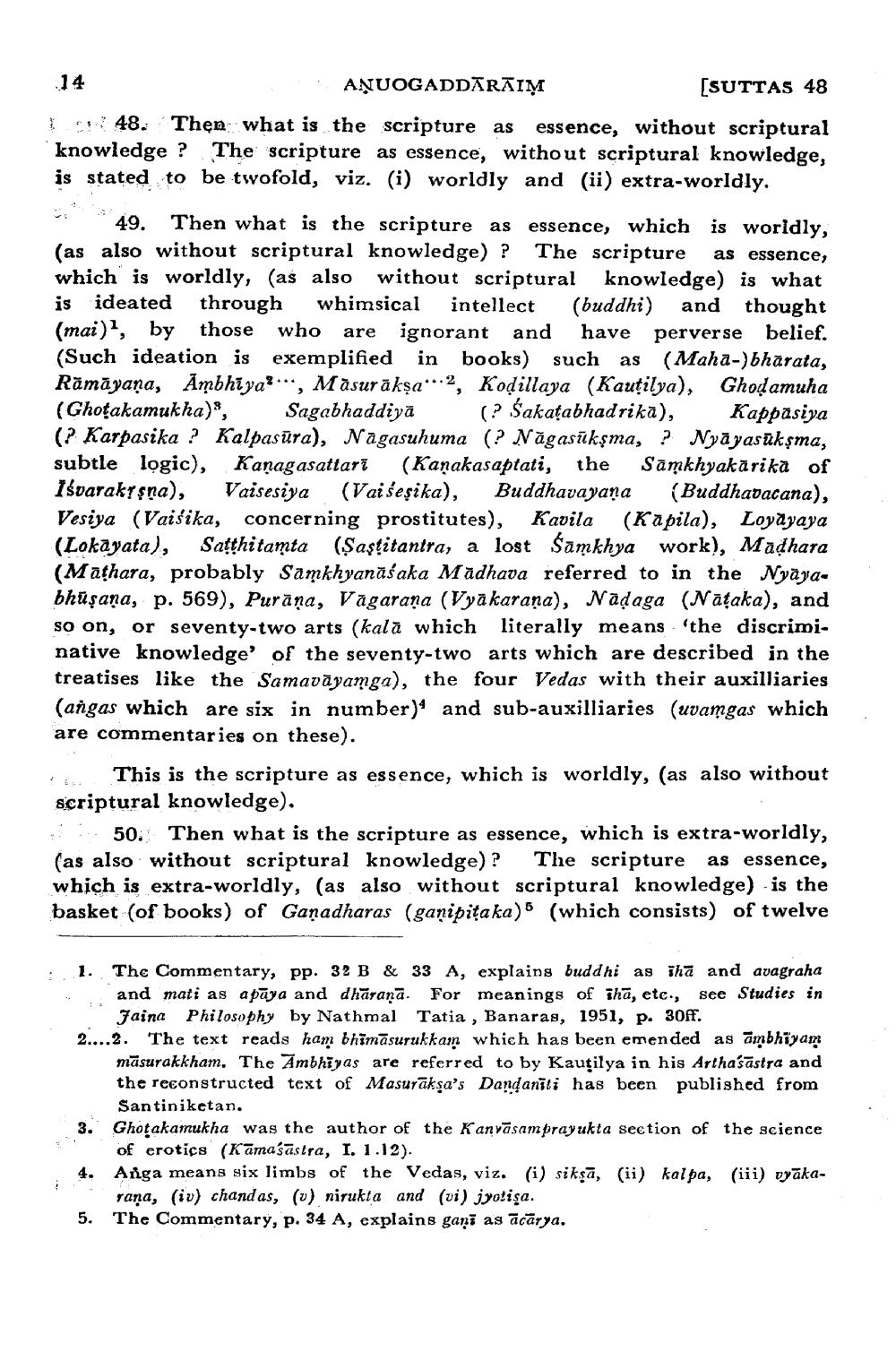________________
14
AṆUOGADDĀRĀIM
[SUTTAS 48
48. Then what is the scripture as essence, without scriptural knowledge? The scripture as essence, without scriptural knowledge, is stated to be twofold, viz. (i) worldly and (ii) extra-worldly.
}
49. Then what is the scripture as essence, which is worldly, (as also without scriptural knowledge) ? The scripture as essence, which is worldly, (as also without scriptural knowledge) is what is ideated through whimsical intellect (buddhi) and thought (mai), by those who are ignorant and have perverse belief. (Such ideation is exemplified in books) such as (Maha-)bharata, Rāmāyaṇa, Ambhiya, Masurākṣa 2, Koḍillaya (Kautilya), Ghoḍamuha (Ghotakamukha), Sagabhaddiya (? Sakaṭabhadrika), Kappasiya (? Karpasika? Kalpasura), Nagasuhuma (? Nagasukṣma, ? Nyayasukṣma, subtle logic), Kanagasattari (Kanakasaptati, the Samkhyakarika of Isvarakṛṣṇa), Vaisesiya (Vaiseṣika), Buddhavayana (Buddhavacana), Vesiya (Vaisika, concerning prostitutes), Kavila (Kapila), Loyayaya (Lokayata), Satthitamta (Saştitantra, a lost Śamkhya work), Maḍhara (Mathara, probably Samkhyanāśaka Mādhava referred to in the Nyayabhuṣaṇa, p. 569), Purana, Vagaraṇa (Vyakaraṇa), Naḍaga (Nataka), and so on, or seventy-two arts (kala which literally means 'the discriminative knowledge' of the seventy-two arts which are described in the treatises like the Samavayamga), the four Vedas with their auxilliaries (angas which are six in number) and sub-auxilliaries (uvamgas which are commentaries on these).
This is the scripture as essence, which is worldly, (as also without scriptural knowledge).
***
50. Then what is the scripture as essence, which is extra-worldly, (as also without scriptural knowledge)? The scripture as essence, which is extra-worldly, (as also without scriptural knowledge) is the basket (of books) of Gaṇadharas (ganipitaka)5 (which consists) of twelve
1. The Commentary, pp. 32 B & 33 A, explains buddhi as iha and avagraha and mati as apaya and dharana. For meanings of iha, etc., see Studies in Jaina Philosophy by Nathmal Tatia, Banaras, 1951, p. 30ff.
2....2. The text reads ham bhimasurukkam which has been emended as ambhiyam māsurakkham. The Ambhiyas are referred to by Kautilya in his Artha'sastra and the reconstructed text of Masuraksa's Dandanīti has been published from
3.
Santiniketan.
Ghotakamukha was the author of the Kanvasamprayukta section of the science of erotics (Kamasastra, I. 1.12).
#
4. Anga means six limbs of the Vedas, viz. (i) siksa, (ii) kalpa, (iii) vyakarana, (iv) chandas, (v) nirukta and (vi) jyotisa.
The Commentary, p. 34 A, explains gani as acārya.
5.




